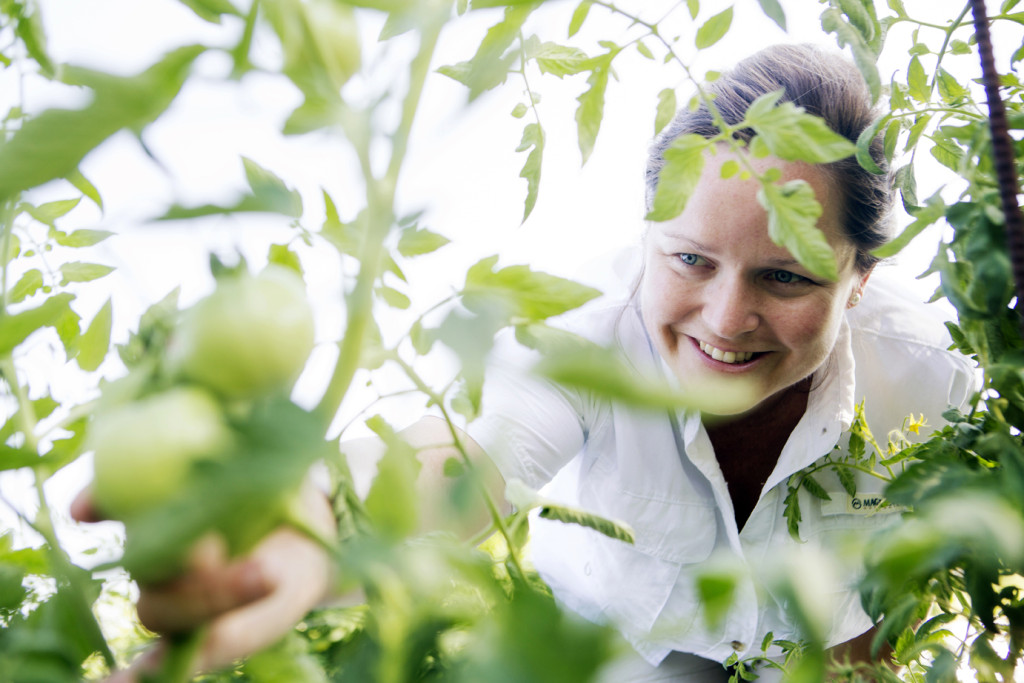
Will the real Creole tomato please stand up?
Tomato specimens LSU researcher Kathryn “Kiki” Fontenot is trying to connect to the Creole tomato. Photos by Collin Richie
The term pops up in grocery stores and farmer markets this summer, but it might not mean what you think it does
In South Louisiana’s summers, you don’t often hear “tomato” without Creole coming first. Restaurants run Creole tomato specials. Consumers search diligently for specimens that measure up to the ones locked in their food memories. There’s even a New Orleans festival devoted to it. But what really is a Creole tomato, and how exactly does it differ from other varieties?
LSU AgCenter Assistant Professor and Extension Specialist Kathryn “Kiki” Fontenot is trying to find out. Earlier this year, she and her team launched a study to see what kinds of consistencies—and inconsistencies—exist in Creoles on the market. They acquired seeds named “Creole” from 11 different sources, including local hardware stores and Internet seed companies, and planted them at the research farm at Burden.
The results have been telling, Fontenot says.
|
|
“There was tremendous difference in the germination rate, and when we put them in the fields, the growth rates were also drastically different,” she says. “Now we’ve started to get a lot of different sizes of fruit, from an extra large cherry to a five- to six-ounce tomato.”

Fontenot says she decided to conduct the study in part because of the lore and interest in the Creole tomato in South Louisiana. Aficionados are quick to claim what constitutes a Creole tomato and have strong feelings about how they should appear and taste. Many suggest that Creoles are medium-sized, often misshapen and that they taste rich and beefy.
But these pronouncements have no scientific merit, says LSU AgCenter’s consumer horticulture specialist Dan Gill.
“I can tell you with absolute positive certainty that the ones you see at the farmers market are not from the [true] Creole cultivar,” Gill says.
The term “Creole” has been liberally used for decades—applied both to a little-used variety developed by LSU researchers and by growers and consumers for decades to identify tomatoes grown in the region.
Gill says that in the ’50s and ’60s, tomato growers in south Louisiana, particularly St. Bernard and Plaquemines parishes, grew several kinds of tomatoes. They referred to them collectively as “Creole” to distinguish them from others grown elsewhere. In other words, “Creole” was used the same way we use the term “local” today.
In 1969, horticulturalists in LSU’s vegetable program developed a new tomato cultivar that was resistant to certain diseases and had characteristics favorable to the region’s conditions. In a move that resulted in “humongous confusion,” says Gill, the scientists gave this new variety the official name “Creole” despite the existing, informal use of the term.
Gill says that Creole cultivar never caught on among growers, who stuck with field-tested varieties or began planting others. LSU’s Creole was an indeterminate plant, meaning it would grow taller and require more staking than the bush-like determinate varieties that came to dominate the world of commercial growers. The Creole was a flash in the pan, and it wasn’t archived at LSU.
“The [Creole] cultivar has been lost along the way,” Gill says, which is why he puts little faith into the idea that tomatoes sold as Creoles are the LSU Creole. “But the name has such magic associated with it because people remember buying flavorful tomatoes from growers years ago that were called Creole.”
Those memories continue to build the mythic flavor found in a “real” Creole. Today, the term is more popular than ever, thanks to the local foods movement. Farm-to-table enthusiasts seek out Creoles in eateries and markets alongside a bevy of heirloom varieties. Seed companies and nurseries still sell so-called Creole tomato seeds and seedlings to backyard and commercial growers drawn to the brand. But as Fontenot has found, these varieties vary.
Fontenot is planning to hold a taste test to chart the flavor profiles of the Creoles she has planted at Burden as well.
She suspects one characteristic of a true Creole could be that it had “green shoulders,” or shades of green encircling the area around the stem. It’s a trait she’s seeing among all the Creoles in her project, and it stands out, since most tomato varieties have been bred to be thoroughly red, she says.
Fontenot says she’ll continue to work on the project and plans to track down more information about the original LSU cultivar. At farmers markets and wherever local produce is sold, you can at least be sure you are getting tomatoes grown nearby. Meanwhile, the debate about what a real Creole tomato is continues this season among its impassioned fans.
Maggie Heyn Richardson is a regular 225 contributor. Follow her on Twitter at @mhrwriter.
|
|
|
